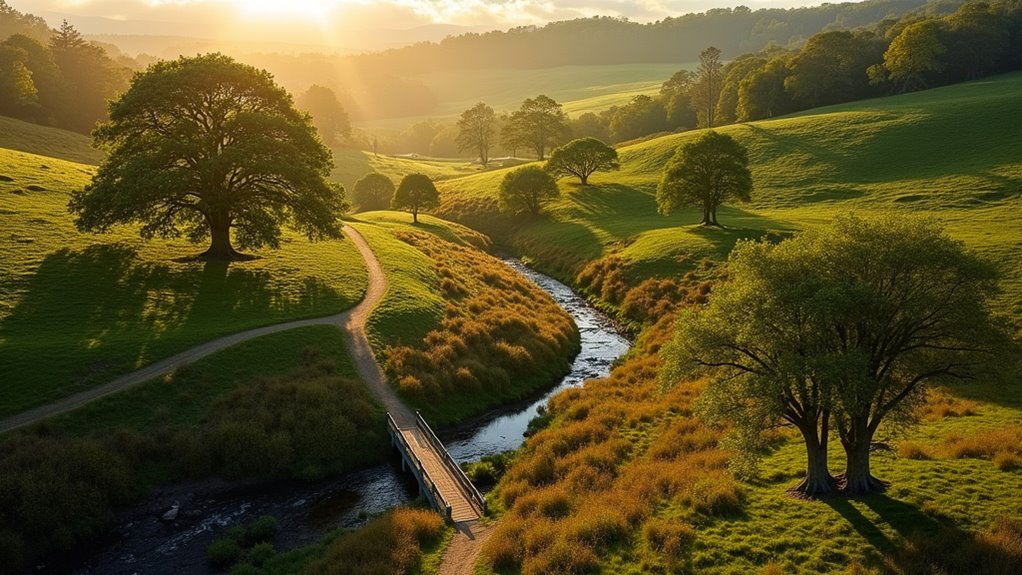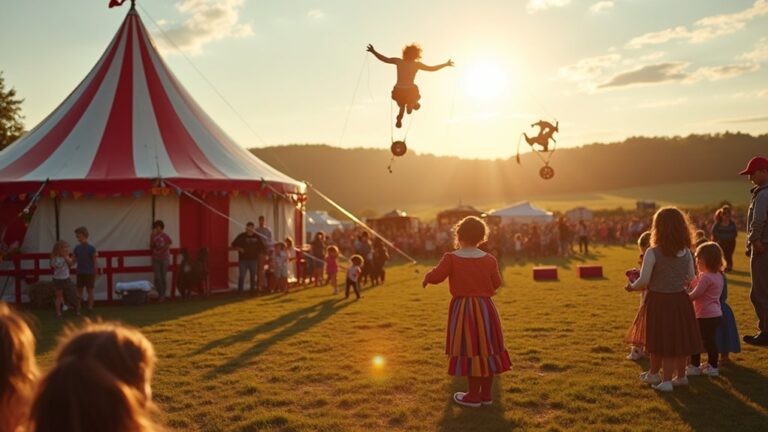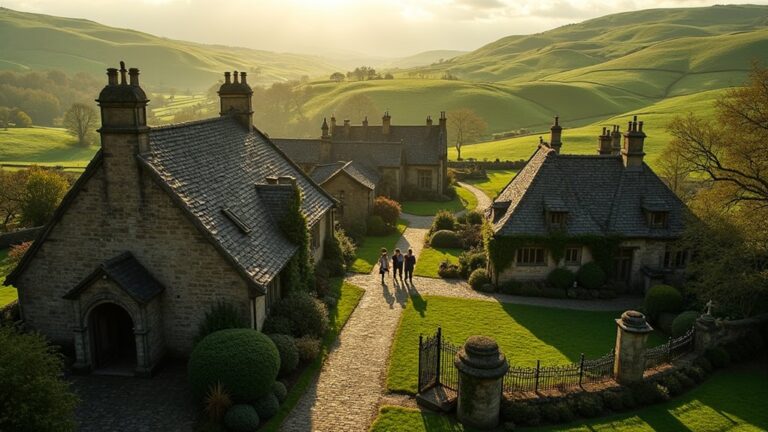You’ll find enchanting Winnie the Pooh locations throughout Sussex’s Ashdown Forest, starting with the iconic Poohsticks Bridge where you can play the famous stick-floating game. Visit Pooh’s House with its “Mr Sanders” sign, explore Galleon’s Lap‘s magical pine trees known as the Enchanted Place, and stop at Pooh Corner Tea Room for themed dining. Don’t miss the North Pole Bridge, Roo’s Sandy Pit, and various forest trails connecting these storybook spots that’ll transport your family straight into Christopher Robin’s adventures.
- Pooh Corner Tea Room and Gift Shop
- Pooh Sticks Bridge Over the Stream
- Winnie the Pooh’s House With Mr Sanders Sign
- Galleons Lap – The Enchanted Place
- The North Pole Bridge in Five Hundred Acre Wood
- Eeyore’s Gloomy Place Near the Valley
- Ashdown Forest – The Real 100 Acre Wood
- Pooh Car Park Starting Point for Forest Walks
- Quarry Car Park Access to Northern Locations
- Chuck Hatch Road Forest Trail Network
- The Sum Up
Pooh Corner Tea Room and Gift Shop
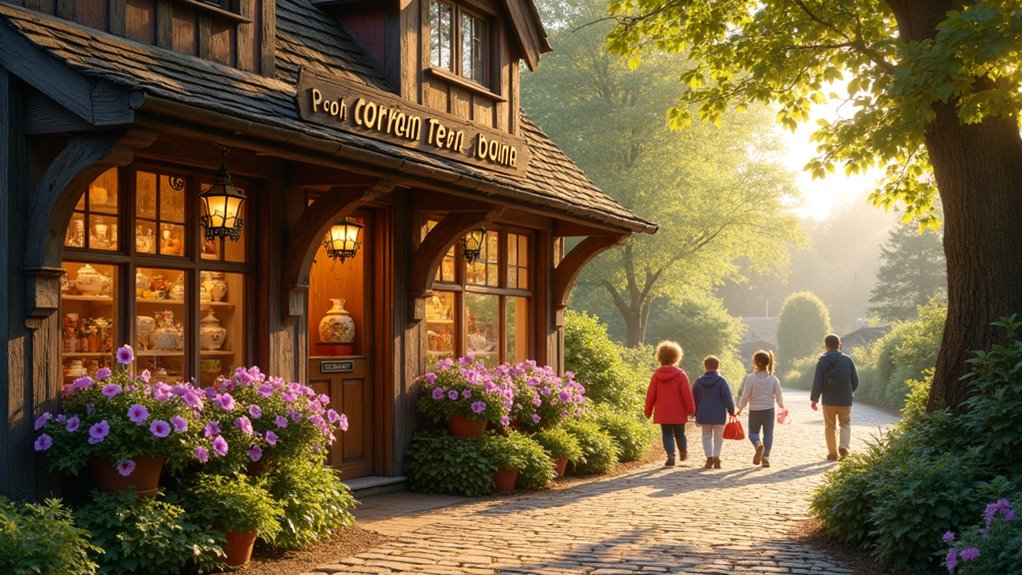
The tea room features two dining spaces: family-friendly Piglet’s Tea Room and the vintage-styled E. H. Shepard Room. You can’t make regular reservations—it’s first-come-first-served, so expect queues during busy periods. The kitchen closes an hour before closing time.
Browse the extensive Pooh-themed gift shop and “Pooh-seum” while waiting for tables. The timber frame building is approximately 300 years old with characteristically low ceilings. Entry’s free; you’ll only pay for food and purchases. They’re open 11:00–17:00 Monday–Saturday and 11:00–16:00 Sundays.
Pooh Sticks Bridge Over the Stream
Where better to experience the magic of A. A. Milne’s beloved stories than at the actual Pooh Sticks Bridge in Ashdown Forest? You’ll find this iconic wooden footbridge over Posingford stream, the very spot that inspired the classic Poohsticks game.
The current bridge replaced the original 1907 structure in the 1970s, with Christopher Robin Milne himself performing the opening ceremony.
You can reach it via a 15-20 minute walk from the free Pooh Car Park on Chuck Hatch Lane, though the path gets muddy after rain.
The bridge offers the perfect family activity – simply drop sticks upstream and watch which emerges first downstream. Just a short walk uphill from the bridge, you’ll discover Winnie the Pooh’s house, often marked by jars of honey thoughtfully left by visiting fans.
Conservation guidelines suggest bringing sticks from home to protect local vegetation while you create lasting Hundred Acre Wood memories.
Winnie the Pooh’s House With Mr Sanders Sign
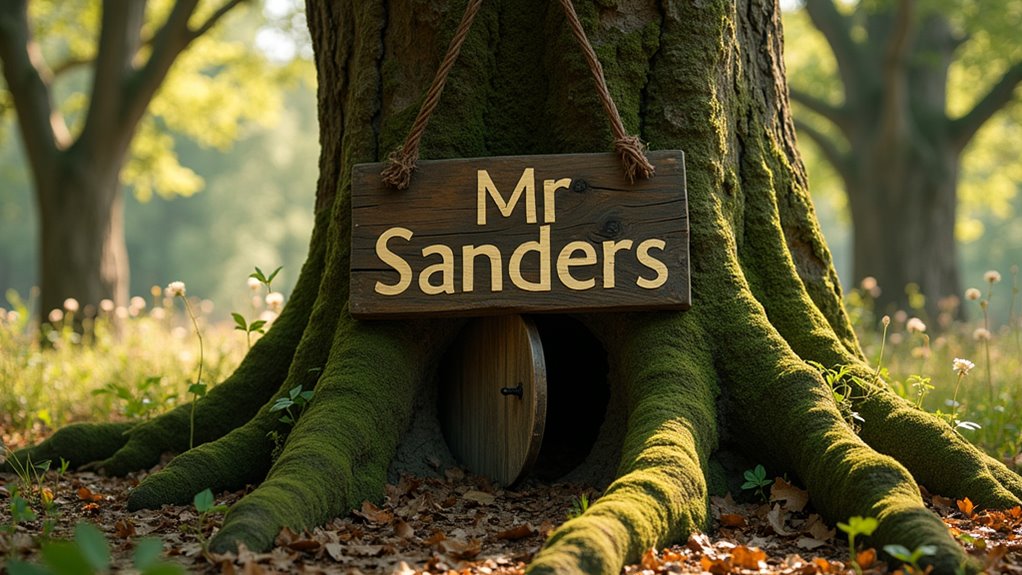
After crossing Pooh Sticks Bridge, you’ll discover Winnie-the-Pooh’s charming house just a few hundred metres up the main path through a gap in the left hedge. The iconic ‘Mr Sanders’ sign marks this beloved woodland dwelling, faithfully recreating Pooh’s home from A.A. Milne’s original stories.
You’ll find visitors have left honey pots as gifts around the red door, where exposed tree branches wrap naturally around the entrance. This enchanting spot represents where Pooh lived “under the name of Sanders” in the tales, inspired by E.H. Shepard’s illustrations of actual Ashdown Forest locations.
The house sits perfectly within the real Hundred Acre Wood, offering families an immersive literary experience. Visitors often note the distinctive smell of honey that helps guide them to this magical location. It’s easily accessible from Pooh Car Park and connects seamlessly with other trail destinations.
Galleons Lap – The Enchanted Place
When you reach Gills Lap, you’ll discover the most poignant location in all of Pooh Country – Galleons Lap, known as the Enchanted Place from The House at Pooh Corner.
This circle of sixty-something Scots pine trees sits atop Ashdown Forest, where Christopher Robin and Pooh shared their final moments together.
You’ll find the clump after a 5-10 minute walk from Gills Lap car park, following the main track north. The trees remain mysteriously uncountable – either 63 or 64 – just as Milne described. A trig point beside the clump offers panoramic forest views.
The open hilltop provides perfect picnic spots without prickly undergrowth, while nearby attractions include Roo’s Sandy Pit and the Heffalump Trap. Information boards help guide visitors through this meaningful landscape.
Though muddy paths aren’t wheelchair accessible, families treasure this unchanged landscape symbolizing childhood’s bittersweet end.
The North Pole Bridge in Five Hundred Acre Wood
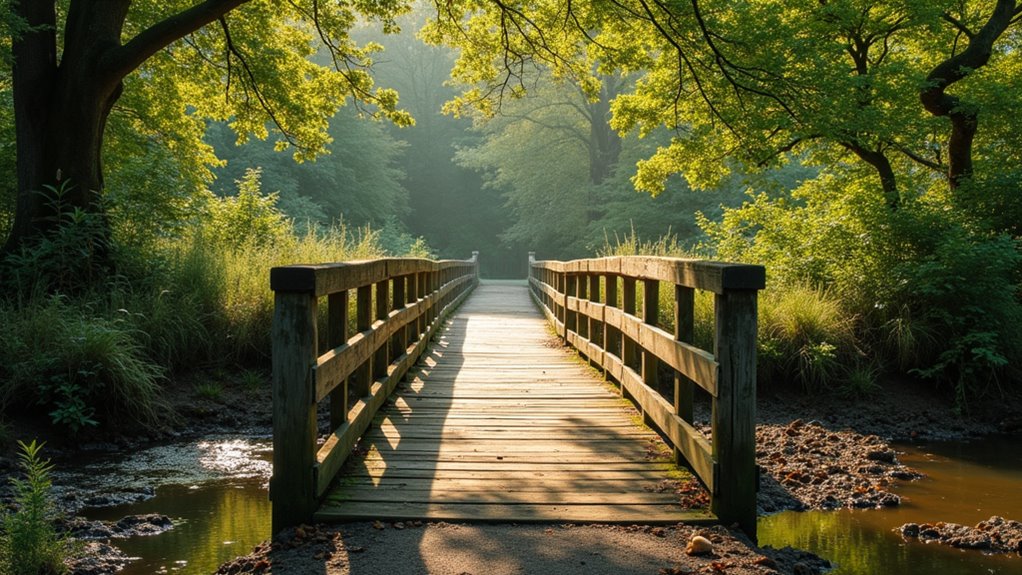
Why not follow in Christopher Robin’s footsteps to discover the North Pole? You’ll find this enchanting bridge nestled at the bottom of a valley in Five Hundred Acre Wood, the real-world inspiration for Milne’s fictional Hundred Acre Wood.
Start from Quarry car park on Chuck Hatch Road, where a footpath leads into the woodland. Bear right downhill to reach the bridge where Pooh’s famous “Expotition to the North Pole” took place.
The route forms part of a signposted Pooh walk network across Ashdown Forest. You’ll need sturdy footwear for the woodland slopes, which can get muddy.
The bridge offers safe stream-side viewing and makes an ideal photo stop. This location is also known as Pooh Sticks Bridge, where visitors enjoy the traditional game of dropping sticks into the river. Children love connecting this real location with the beloved stories, creating an imaginative outdoor adventure.
Eeyore’s Gloomy Place Near the Valley
Beyond the North Pole bridge, you’ll discover Eeyore’s Gloomy Place tucked away in Wren’s Warren Valley, where the melancholy donkey from Milne’s stories would feel right at home. This “rather boggy and sad” location sits somewhere below the main path that contours the valley’s edge, though no exact spot is officially marked.
You’ll find the atmosphere genuinely matches Eeyore’s mood on cold, wet days when low light and damp ground create that characteristic gloominess. However, don’t let this deter you—the same area transforms into something gorgeous during spring and summer, especially when bluebells bloom. The Gills Lap car park nearby features a helpful map and memorial plaque dedicated to A.A. Milne and illustrator E.H. Shepard.
The terrain here isn’t suitable for prams or very young children due to steep, uneven sections that become particularly muddy after rain.
Ashdown Forest – The Real 100 Acre Wood
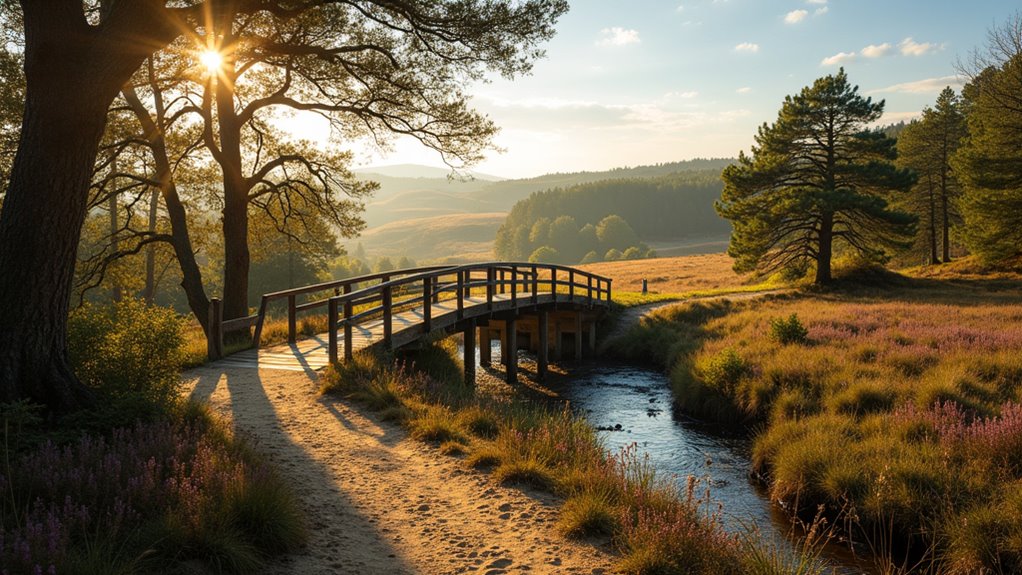
Ashdown Forest stretches across East Sussex as the authentic inspiration behind A.A. Milne’s beloved Hundred Acre Wood. You’ll discover the landscape remains largely unchanged since the 1920s, when Milne purchased Cotchford Farm near Hartfield and explored these heaths with his son Christopher Robin.
You can access the forest through over 40 public car parks, with Pooh Car Park and Gills Lap particularly popular for family walks. The terrain features open heathland, gorse, and scattered pine clumps that create gentle, manageable trails for children. The forest welcomes well-behaved dogs on leads, making it perfect for family adventures with four-legged companions.
Real place-names inspired story locations – Gills Lap became Galleon’s Lap, while Five Hundred Acre Wood influenced the famous Hundred Acre Wood. You’ll walk through authentic Pooh Country where literary magic was born.
Pooh Car Park Starting Point for Forest Walks
The Pooh Car Park on Chuck Hatch Lane serves as your ideal starting point for exploring Winnie-the-Pooh’s most famous locations in Ashdown Forest. Located just off the B2026 south of Hartfield village, you’ll find this small rural car park using postcode TN7 4EX for your sat nav.
You’ll enjoy the quickest route to Pooh Sticks Bridge from here – just 10-15 minutes downhill along a well-made gravel track that’s buggy-friendly. Along the way, you’ll spot Owl’s House and Piglet’s House beside the path, plus wooden waymarkers guide your route.
Don’t miss the wooden forts near the car park entrance – they’re perfect for extra play time. The location is approximately two hours drive from London, making it an accessible day trip destination. Remember, parking fees may apply, and there aren’t any facilities here.
Quarry Car Park Access to Northern Locations

For exploring Winnie-the-Pooh’s northern locations, you’ll want to head to Quarry Car Park on Chuck Hatch Road. This small to medium-sized gravel car park offers free parking and serves as your gateway to Roo’s Sandy Pit—the disused sandstone quarry that gives the car park its name.
From here, you can explore the sunken, bowl-like quarry area where sandy soil has become grassed and wooded. Take the footpath almost opposite the car park and bear right through woodland to reach the wooden bridge at the valley bottom—this is the story’s North Pole where Pooh and Christopher Robin camped. The area features streams with waterfalls and ponds that bring the stories to life.
The car park connects easily with nearby Gills Lap and forms part of the popular Long Pooh Walk circuit.
Chuck Hatch Road Forest Trail Network
Beyond Quarry Car Park, Chuck Hatch Road opens up an extensive trail network that’ll take you deeper into Ashdown Forest’s literary landscape. The 4.7km out-and-back route to Gallypot Street offers families a perfect introduction to Pooh country, taking roughly 1 hour 9 minutes with gentle 134m elevation gains.
You’ll traverse rolling hills through ancient woodlands and open heathland. Reaching a scenic viewpoint at the 2.5km mark, you’ll be treated to stunning countryside panoramas.
The trail connects you to the famous Poohsticks Bridge via Pooh Bridge Car Park, where the original 1907 Posingford Bridge was rebuilt twice with Disney’s support. This enchanting landscape was once a royal hunting ground, steeped in medieval history that adds an extra layer of magic to your family adventure.
Pack essentials including water and poo bags, as no facilities exist along the route. The well-marked grass and dirt paths suit families perfectly, though keep dogs controlled around grazing Exmoor ponies.
The Sum Up
You’ll create magical memories exploring these enchanted Winnie the Pooh locations with your family. Start at Pooh Corner for maps and souvenirs, then follow the trails through Ashdown Forest to discover Poohsticks Bridge and the Enchanted Place. Don’t forget your camera – you’ll want to capture those special moments at Pooh’s house and the North Pole. Pack snacks, wear comfortable shoes, and prepare for an adventure that’ll transport you straight into A.A. Milne’s beloved stories.

